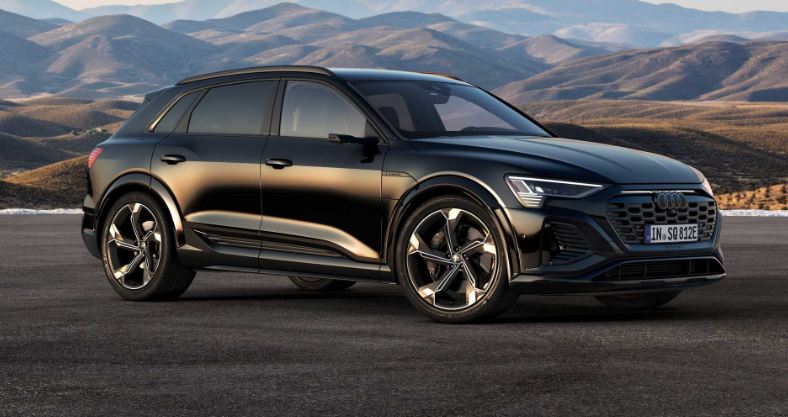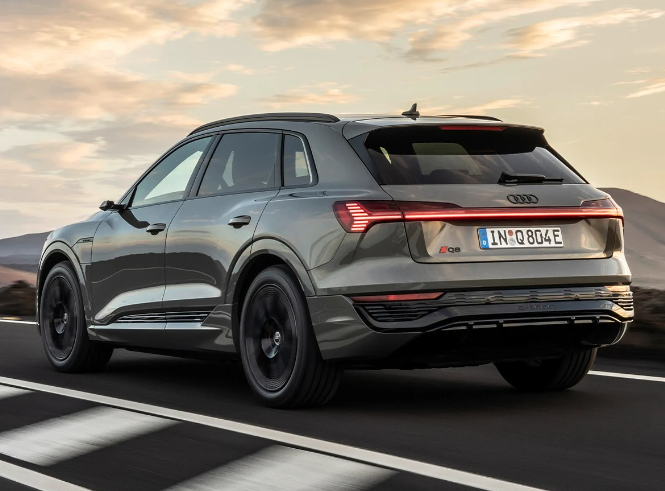Audi E-Tron Sportback and SUV were the first electric SUVs. They’re now changing the landscape for the better. We were fortunate enough to be able to drive the new Audi Q8 E-Tron Sportback and SUV, which was renamed 2024 Audi Q8 E-Tron, in Lanzarote. Lanzarote is known as the island of volcanoes.

The E-Tron arrived in the spring of 2019 with no direct competitors. Only the Tesla Model X, a quirky electric vehicle, and the smaller Jaguar I-Pace were the closest rivals. The Q8 E-Tron, with its expected range of 300 miles, is a mid-market vehicle that can compete against the BMW iX and Cadillac Lyriq.
2024 Audi Q8 E-Tron Changes
The Q8 E-Tron, like its predecessor as well as the smaller Q4 E-Tron line-up, is available in two body types: SUV and Sportback. The front seats are the same, but the Sportback’s roofline is tapered and coupe-like, limiting rear-seat room and cargo space. Audi’s mid-cycle update shows that it is well aware of its E-Tron model’s strengths and weaknesses. Audi focused its efforts on a single thing, namely increasing the range of the Q8 E-Tron.
The range addresses something Audi executives–especially those on the U.S. side–have freely admitted since around the time of the e-tron’s launch. The Q8 E-Tron now has a larger capacity pack, which is 114 kWh instead of 95 kWh. This results in 106 kWh usable capacity. Audi has packed more prismatic cells in the same-sized battery box than ever before. Audi has also switched to nickel cobalt aluminum (NCA), cell chemistry.
Audi expects a 30% increase in range for the Q8 E-Tron compared to the previous E-Tron. This is due to the battery pack providing 23% more energy. Audi’s aerodynamic improvements, including the addition of active grille shutters, and a re-examination of the underbody aero have contributed to this. Most notably, an underbody spoiler has been added that directs airflow around wheels. These changes resulted in a drag coefficient of 0.27 for Sportbacks and 0.29 for SUVs, according to U.S. standards.
Comparing my observations with my other E-Tron drives, I can see improvement. Audi’s chosen venue was mild, with no elevation change. It wasn’t a serious test for the Q8 E-Tron. According to the trip computer of the SQ8, the least efficient model in the lineup achieved 2.5 miles per kWh over 85 miles of zigzagging around the volcanic island. Most of this was done at 45 mph and less with some higher speeds. In a much shorter trip, the Q8 S line managed to achieve that same figure. This is a significant improvement over the previous model in terms of efficiency. Multiplying 265 miles suggests an increase in real-world driving range of at least 25 percent.
The Q8 E-Tron models handle better on tight, curved island roads. I have driven the dual-motor E-Tron Sportback and SUV models for many years. The Q8 E-Tron models are more agile than the previous versions. Audi changed the steering rack to one that has a faster ratio (14.6:1 for the Q8 E-Tron, versus 15:8 in the previous E-Tron) to give this impression. Audi used a stiffer control arm for the front axle, as well as new bushings to achieve these quick directional shifts without adding harshness.
All versions have an air-adaptive suspension that allows for a 3.0-inch adjustment in body height. Audi also revised the tuning for the Q8 E-Tron’s steering, suspension, and ride height as well as the torque distribution. The Q8 E-Tron has five main modes: Offroad, Allroad, Comfort, Efficiency, and Auto. These modes take full advantage of the vehicle’s ride height flexibility and traction versatility.
Both versions of the system default to rear-wheel driving under light cruising conditions. However, it will more quickly direct power toward the front motors and front wheels if needed. The Q8 Etron family’s core performance numbers haven’t changed much since they were introduced in the U.S. The Q8 E-Tron55 has a dual motor that produces 402 hp, and the SQ8 E-Tron uses three motors to produce a total of 496 hp.
Audi claims that the battery is heavier because it’s more densely packed, but the 15 pounds of weight savings from the underbody shielding and other items almost offsets this. Audi claims that with the same drive ratios, it will be able to reach 62 mph at the same time in 2022. The SQ8 model will take 4.5 seconds, while the U.S.-spec Q8 55 is expected to arrive in 5.6 seconds. All versions of the E-Tron have asynchronous motors (induction). However, regardless of which version you choose, the motors installed on the rear axle will now have 14 instead of 12. The motor can now produce light torque using less energy, which is essential for “gliding.”

Audi claims that these motors are more efficient at high speeds and reduce the dependency on rare-earth metals. The SQ8 may not have the same standing-start rip as some EVs, but it is a lot more enthusiastic from a rolling start onwards and has surprisingly little body movement compared to other large SUVs.
Audi doesn’t believe in one-pedal driving, which is a common practice among other EVs. They see it as a detriment to efficiency and range. The E-Tron, unlike Tesla and Lucid which do not dial in additional regen to the brake pedal or most other EVs who physically blend in brake pads, uses a brake system that performs all braking up to 0.3g with the motor/generators. The E-Tron brake pedal feels great in real-world driving. It’s perfect for driving at stoplights or behind rental-car drivers who are hesitant. This includes rivals like the Mercedes EQS and BMW iX. Audi claims that its brakes recover more energy than competitors that blend the brake pads in.
Charging System
It may be easier to charge at roadside stops, despite the larger battery pack. Audi says that there were no DC fast-charge opportunities along the route, but it has managed to improve the charge curve in the most important areas. The charge peak is now 170 kw instead of 150 kW. It occurs at around 60% charge state, where road-trippers will notice. Even with a larger battery pack, the Q8 E-Tron can charge from 10 to 80% in just 31 minutes. The Q8 E-Tron also comes with an 11-kw charger onboard, which is enough to charge the battery in under 10 hours using a 240-volt source.
Aside from range, steering, and charging, the Q8 E-Tron is remarkably similar to the previous E-Tron. The upper and lower body trim pieces have been aligned to make the vehicle look more coordinated. The grille is adorned with a new Audi logo that appears smaller than the previous version. The SQ8 has a bit more exterior brightwork than the Advanced and S-Line models. However, with the full range of trim options available, you can have your car exactly how you want it.

Audi has largely left the cabin alone, with some updated materials. The S-Line gets a lighter walnut wood trim and synthetic leather with recycled microfibers. The Q8 E-Tron is still a luxury vehicle, thanks to its ability to mute road and wind noise, provide comfortable, supportive seating for all adults, and have intuitive, sturdy switches.
Dual-screen layout with a 10.1″ touchscreen on top for communication, entertainment, and navigation and an 8.6″ haptic display down below that is primarily used to control the climate. You can customize the instrument display by using steering-wheel controls. A head-up display option is also available. Audi is still seeking U.S. approval for its virtual exterior mirrors (camera-based), so we’re stuck with physical mirrors.
2024 Audi Q8 E-Tron Price & Release Date
Audi says that the U.S. model will receive a slight price increase in the transition to the Q8 E-Tron 2024, but there won’t be any major changes. The 2023 Audi E-Tron starts at $71,995, which includes the destination. The E-Tron Sportback begins at $75,790. The starting prices for both body styles of the S are $89,395 & $91,995. The E-Tron is a luxury electric SUV that will continue to change rapidly just like the volcanic landscape.